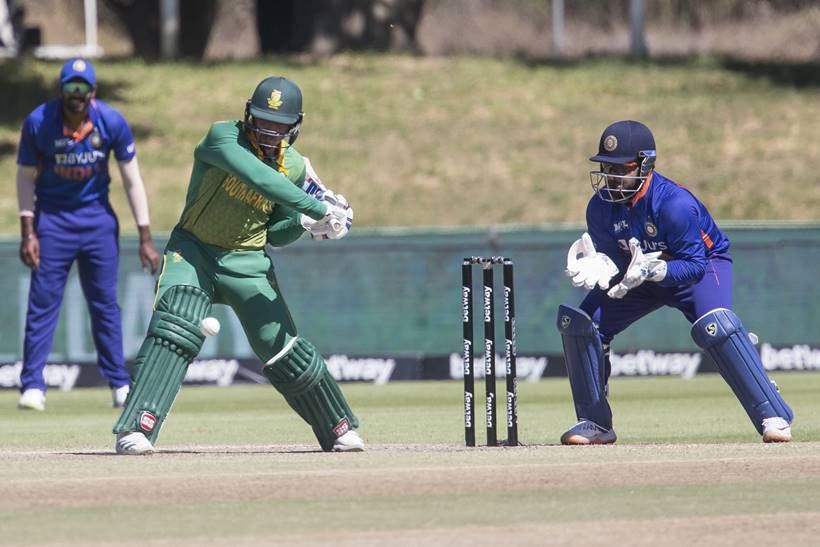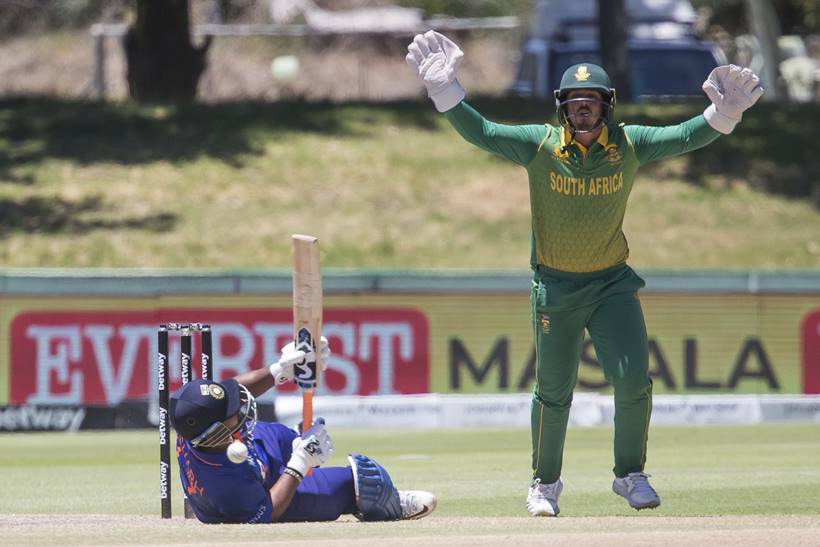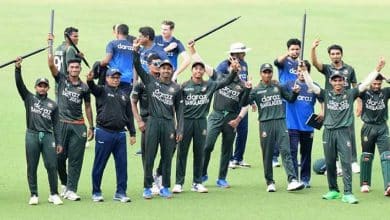India lose second ODI on the trot against SA to concede series

India need to change their white-ball template. That’s the biggest lesson from their ODI series defeat against South Africa.
Except Rishabh Pant, and Shardul Thakur and Ravichandran Ashwin’s 48-run partnership at the death, the tourists played fearful cricket in the second ODI as well, losing the game by seven wickets and with that the three-match series.
What India lacked was Quinton de Kock’s boldness upfront, which proved to be the major difference. The left-hander grabbed the game by the lapels, targeting Bhuvneshwar Kumar at the outset on a used Boland Park pitch, where the older ball gripped and lost its pace off the deck. De Kock’s 78 runs off 66 balls, and a 132-run opening partnership with Janneman Malan, slammed the door shut on India. Malan made 91 in 108 deliveries, as the Proteas comfortably chased down 288 for victory, with 11 balls remaining.
He was ready to live by the sword. That’s the job of the batting enforcers in shorter formats, the occasional fallouts notwithstanding. Jason Roy and Jonny Bairstow do it for England. David Warner and Aaron Finch do it for Australia. Martin Guptill and Fakhar Zaman play that role for New Zealand and Pakistan respectively.
 De Kock had his share of luck, when Pant missed an easy stumping. (AP)
De Kock had his share of luck, when Pant missed an easy stumping. (AP)
Shikhar Dhawan is the designated enforcer in the Indian team at the top. But seldom does he score run-a-ball in the first Powerplay. On Friday, he got out for 29 off 38 deliveries. India’s start was slow compared to their opponents; 57 for no loss after 10 overs against South Africa’s 66 for no loss after 10. On a sluggish pitch, the hard new ball presented the best chance to score quickly.
India badly missed Rohit Sharma in this tour, both in Tests and the ODIs. Rohit, too, takes a little bit of time before opening up in white-ball cricket. But his range allows him that leeway. Rahul, usually a free-flowing batsman down the order in 50-over cricket, became cagey, as he promoted himself to open the innings. Playing the role of an anchor, he scored 55 all right, but never did he look to be dominating the bowling. His 115-run third wicket partnership with Pant was important for India’s recovery after they lost Dhawan and Kohli in quick succession, the latter to a five-ball duck. But curbing his natural stroke-play didn’t augur well for his team in both ODIs.
This Indian batting line-up has also developed a habit of falling prey to soft dismissals or slogging after putting itself under pressure. It cost India the T20 World Cup. It hindered them in the ODIs here as well. Rahul scored at a sub-70 strike rate. Dhawan’s was a little better, 76-plus. Shreyas Iyer and Venkatesh Iyer’s strike rates were 78 and 66 respectively. It was 1990s cricket. Only Pant, Shardul and Ashwin scored their runs at 100-plus strike rates.
 Rishabh Pant played a few audacious shots in his innings. (AP)
Rishabh Pant played a few audacious shots in his innings. (AP)
Pant was the lone specialist batsman to thrive on his boldness. After laying into Keshav Maharaj, he slog-swept Tabraiz Shamsi for a four followed by another boundary next ball, through a conventional sweep. When the chinaman bowler removed the slip fielder and put an extra man on the leg side, Pant used the depth of the crease and late-cut Shamsi for a four.
He reached his half-century in 43 balls, got to his ODI career-best 85, but holed out at long-on to the bowling off Shamsi. It put paid to India’s hopes of posting a 300-plus total, par score in modern-day ODIs. Then again, Pant was the only batsman who forced the South African bowlers to think differently.
His contribution to the 115-run partnership was 83 off 65 balls, while Rahul made 31 off 46. South Africa had a gilt-edged opportunity to nip the association in the bud, when both batsmen were stranded at one end, but Maharaj failed to collect Temba Bavuma’s throw. India were 70/2 then. Later, Rahul got a reprieve on 46, Aiden Markram dropping a fairly regulation catch at point off Andile Phehlukwayo’s bowling.
India’s non-use of Suryakumar Yadav in the two ODIs was a result of conservative thinking. The team management did the right thing by sticking to Venkatesh Iyer, but a player like Yadav is an asset in the shorter formats. It’s for the think-tank to decide who among the specialist batsmen should make way for him. Yadav’s 360-degree batting provides the x-factor and keeps the bowlers on their toes. He is innovative enough not to slog his way out of trouble.
When India bowled, the biggest question was why haven’t the selectors moved on from Bhuvneshwar Kumar yet. The medium pacer opened the bowling with Jasprit Bumrah and De Kock gleefully collected two fours and a six in his first over. Kumar looked pedestrian. In eight overs, he conceded 67 runs without ever looking effective. Meanwhile, de Kock wasn’t afraid to take the attack to Bumrah either.
As for tactics, removing Shardul right after he broke the opening partnership was questionable as also the fact that Ashwin and Yuzvendra Chahal bowled only four overs in tandem, two at the top and two after the game was lost. At the same time, yet again, the Indian spinners were outbowled by their South African counterparts.
The Saffers had some jitters after losing two quick wickets, a Bumrah delivery ricocheting off Malan’s gloves and hitting the stumps and Bavuma offering a return catch to Chahal. But a rapid opening partnership meant that the hosts were never under any asking-rate pressure. They sauntered to the highest ODI run-chase at this venue, attesting that India’s short-form bowling needed a major shake-up.





